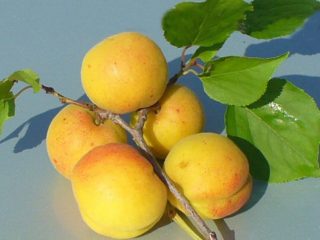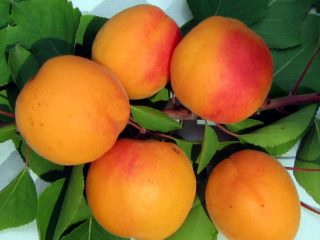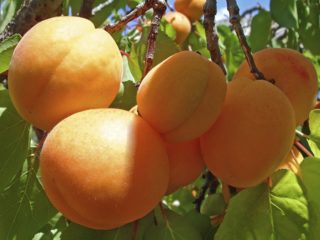Content
The Viking apricot lives up to its name, since the tree is undersized, but rather spreading. Possesses a powerful crown. Flowering occurs in the spring months. Viking apricot fruits with a delicate taste, juicy, with a high nutritional value. In addition, they are characterized by large size, beautiful bright yellow color.
Breeding history
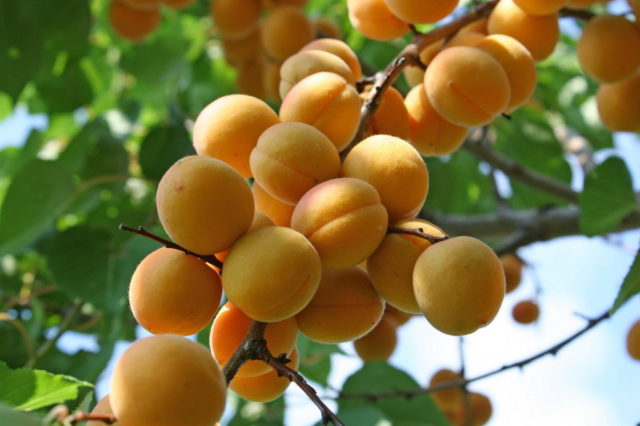
Viking apricot fruit is slightly larger than other species
Common apricot is a fruit tree from the Plum genus, the Pink family. The exact origin of this deciduous tree has not yet been established. Many are inclined towards the version in favor of the Tien Shan Valley in China. However, the French biologist de Perderle in the 18th century noted in his writings that Armenia can be considered the probable homeland of apricot, since it was from there that the fruits were first brought to Greece, and then came to Italy and spread throughout Europe. For a long time it was called the "Armenian apple".
In the wild, the apricot tree has survived only in the west of the Caucasus, the Tien Shan and in the Himalayas. At the moment, it is actively grown in countries with a temperate climate. In Russia, apricot is common in the Caucasus and southern regions.
Apricot breeding work was started by Michurin in the 19th century. Further work was continued by the scientists of the Voronezh region. They worked in several directions: they sowed seeds from random fruits and Michurin varieties, and the resulting specimens were crossed with European and Central Asian species. Many known varieties were obtained in this way.
As for the Viking apricot variety, this is the result of the fruitful work of the employees of the Michurin All-Russian Research Institute of Genetics and Breeding of Fruit Plants. The Kruzhkov breeders became the authors of this variety. Through many years of experience, they obtained a new full-fledged variety with strong immunity and a high degree of frost resistance.
Description of the Viking apricot variety
Viking reaches a height of up to 5 m, the crown is rather spreading, rounded. Green leaf plates, elongated with a pointed end, about 5-6 cm. The bark of a tree is brown with longitudinal cracking. Young shoots of a reddish shade with small lenticels.
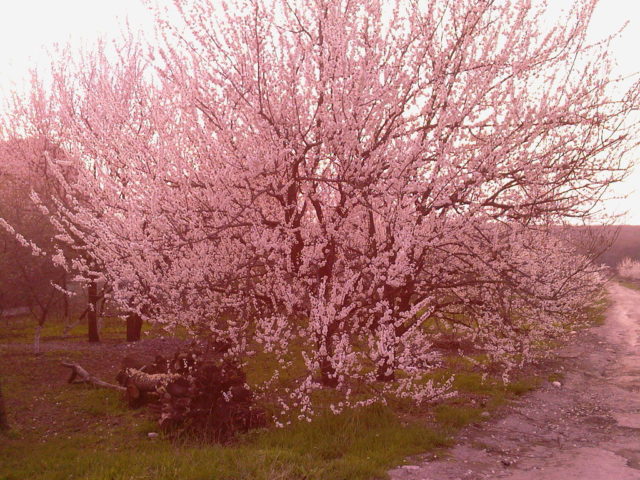
Viking apricot blooms before foliage appears
Flowering occurs in April. After that, fruits of a rich yellow color ripen, rather large, fleshy and juicy with a pleasant taste and smell. Flowers are solitary on short pedicels, about 25 mm in diameter. The petals are white-pink with veins.
Characteristics
Viking apricot was created for cultivation in the central regions of Russia. Therefore, its basic properties and characteristics differ from other varieties. It is often planted in small areas because it is not possible to grow a large number of shrubs and trees.
Drought tolerance
The Viking apricot variety has a high heat and drought resistance. In this regard, it is unpretentious and does without regular watering in dry summers. However, it is important to remember that timely watering is required for full flowering, fruiting, and a good harvest. To retain moisture, a mulching procedure is required.
Frost resistance of Viking apricot
Among the important advantages of the Viking is its frost resistance. The tree easily tolerates low temperatures down to -35 ° C. However, this does not mean that the culture does not need protection from frost with special covering materials. In addition, the apricot does not tolerate sharp fluctuations in temperature.
Viking apricot pollinators
This apricot variety belongs to the category of self-pollinating fruit crops. This means that they do not need pollinators as neighbors for good fruiting. Despite this, for a high degree of yield, experienced gardeners prefer to insure themselves by planting donor plants on their site. They are subject to special requirements:
- compliance with the terms of ripening and flowering;
- high rates of pollination;
- belonging to those plants that are capable of growing in certain soil and climatic conditions.
Under these conditions, the tree will show high yields in the future.
Flowering period and ripening time
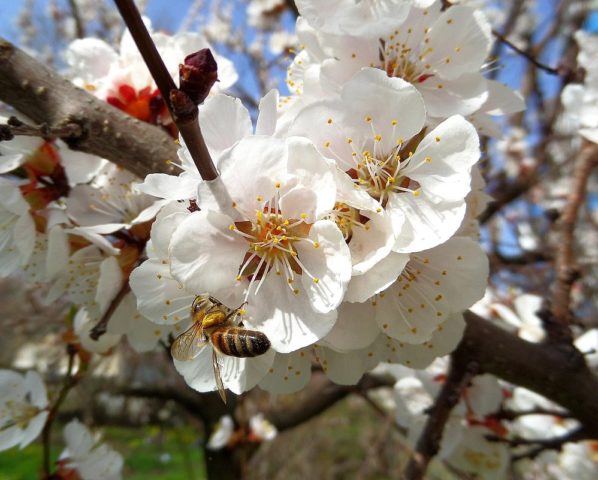
Apricot flowers of white or pale pink hue
The flowering and ripening period depends on the climatic conditions in which the tree grows. But if we take the indicators for central Russia, then flowering occurs at the end of April - beginning of May. In this case, the inflorescences appear on the tree much earlier than the green mass. During this period, the apricot exudes a delicate aroma. Flowering ends after 10 days, and the fruiting period begins. The fruits are formed, and after that they gain weight. The harvest time is in August.
Productivity, fruiting
Considering the climatic and weather conditions, competent care of the Viking tree, a good harvest can be expected. On a large scale, up to 13 tons of fruits are harvested from 1 hectare of planting. However, beginners in horticulture should understand that the first fruiting will happen no earlier than 4 years after planting the seedling.
Scope of the fruit
The Viking apricot fruit is rich in vitamins and minerals, it is considered a dietary product, since its calorie content is low. Homemade preparations are made from the fruits: preserves, jams, compotes, liqueurs and wines. In addition, apricot tastes good as a filling in pies and dumplings. The fruits are actively dried - in this form, the product does not lose its value. Marzipan is made from the cores located inside the seed.
Disease and pest resistance
The Viking variety has good immunity and is very resistant to diseases and pests. But this is provided that the tree is properly cared for, and the basic rules were followed when planting. It is possible to prevent the appearance of diseases and the attack of pests when carrying out preventive measures.
Advantages and disadvantages
Viking has long gained popularity among many gardeners, thanks to a number of positive qualities of this variety:
- frost resistance, drought resistance;
- high productivity;
- large fruits;
- self-pollination;
- good taste and marketability;
- early fruiting.

Delicious pies are made from apricot, but more often jam and compotes are made from it.
Like any other crop, the Viking variety has a number of disadvantages. Among them, shedding of fruits during overripening, regular pruning, since the crown is large and dense, was noted. In addition, the tree is demanding for lighting.
Landing features
The planting procedure must be approached carefully, since the subsequent yield, resistance to diseases and pests largely depends on it. Therefore, it is necessary to follow a number of rules that gardeners use.
Recommended timing
Viking is one of those fruit trees, the seedlings of which do not need to be planted in the fall. The culture is thermophilic, and it will be difficult for it to adapt in a cold environment. The best period for planting is the second half of April. At this time, you can not be afraid of night frosts, and the soil is already warmed up enough. In the south of Russia, planting can be done much earlier.
Choosing the right place
Viking requires a lot of light and does not tolerate drafts. Therefore, a site is needed on a small hill with a groundwater table of at least 2.5 m. Otherwise, the root system may suffer from excessive moisture.
Viking prefers loamy soil, black soil. It reacts extremely badly to acidic soil, therefore, the soil must be limed before planting.
What crops can and cannot be planted next to an apricot
In terms of neighborhood, apricot is a rather capricious culture. He will not tolerate an apple tree or a pear next to him. It is believed that apricot will compete with stone fruit crops for moisture and nutritional components. The apple tree and pear can be negatively affected by toxic substances secreted by the apricot roots. The tree will be negatively affected by conifers, black currants, walnuts. Of all the fruit and berry plants, the apricot is able to exist peacefully with raspberries and plums, of course, with proper care.
Selection and preparation of planting material
When choosing a Viking seedling, you need to pay attention to its quality. It is quite possible to determine visually:
- bark without traces of damage;
- the color of the trunk and shoots is uniform, without spots;
- whole shoots, with buds;
- the base of the stem at the roots is not less than 10 mm;
- developed root system without signs of decay and dry areas.
The presence of grafting at the root collar will indicate a varietal seedling.
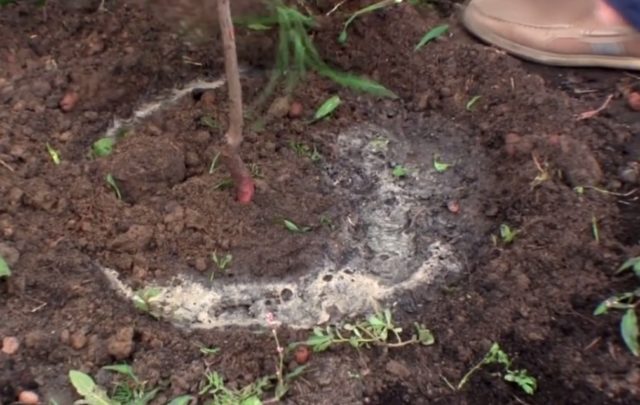
The root collar of the apricot seedling should protrude 4 cm from the ground
Special preparation of the seedling is not required. It is advisable to plant it immediately after purchase. Before planting for several hours, you need to lower the roots in a solution of a rooting stimulator.
Landing algorithm
The Viking apricot planting algorithm is simple and looks like this:
- Dig a hole of the required size.
- Mix the soil from it with humus and add wood ash and superphosphate.
- Put drainage on the bottom.
- Next is a layer of nutrient mixture.
- Drive a wooden peg into the middle, which will serve as a support for the seedling.
- Put a seedling in the hole, and gently spread the roots.
- Cover with soil, while leaving 3-4 cm of the root collar on the surface.
- Compact the soil, then mulch.
- Tie the seedling to the peg.
Next, you can make a convenient ditch for watering a young tree.
Follow-up care of the culture
In the early years, a Viking seedling will require close attention and proper care. The gardener must provide the young apricot with watering, especially the first year, timely pruning to form the correct crown, and fertilization. It is important to provide the culture with reliable protection from frost when cold weather sets in.
Diseases and pests
Despite the good resistance of the Viking variety to diseases and parasites, you should be aware of the potential enemies of the apricot. Of the pests, they can annoy him:
- aphid;
- leaf roll;
- moth.
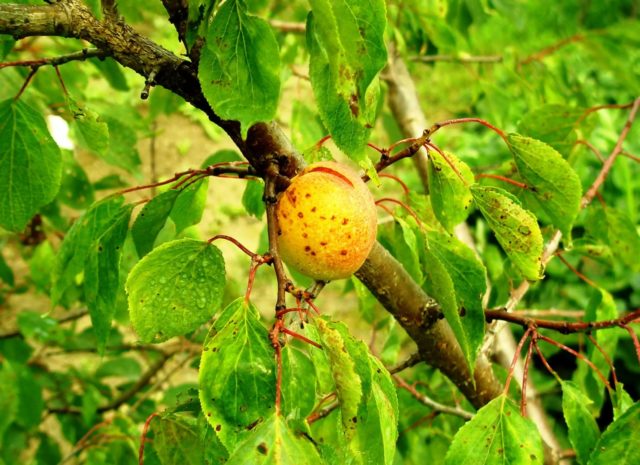
Apricot moniliosis responds well to treatment with special drugs
Of the diseases, apricot is susceptible to leaf spot, fruit rot, and bacterial cancer. Diseases and parasites can be fought with the help of special drugs.
Conclusion
The Viking apricot is a relatively new fruit tree variety, but quickly gained popularity. Recommended for growing in central Russia, as it is resistant to frost and drought. Viking has good immunity, which allows the plant to withstand attacks from parasites and resist disease.


